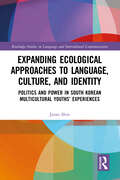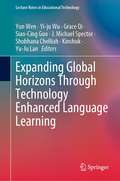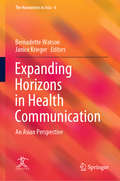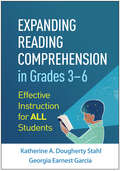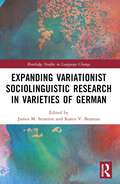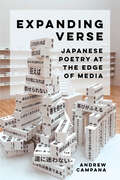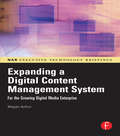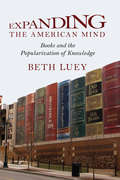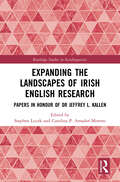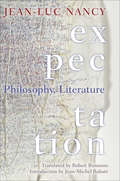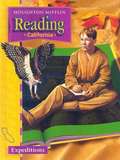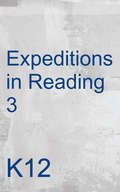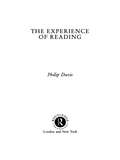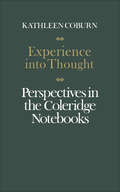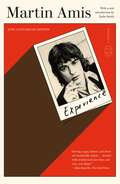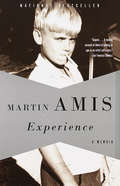- Table View
- List View
Expanding Ecological Approaches to Language, Culture, and Identity: Politics and Power in South Korean Multicultural Youths’ Experiences (Routledge Studies in Language and Intercultural Communication)
by Jaran ShinThis book explores the process of identity (re)construction among mixed-heritage children within the context of globalization through the lens of its intersection with Korean society. The volume illustrates how these multicultural children mediate hybrid social spaces and examines their personal approaches toward translating, resisting, and transforming the entanglements engendered in those spaces. By tracing the trajectories of their identity (re)formations over several years, the book details the paths these youths have taken to navigate diverse contact zones and cope with institutional regulatory mechanisms. It highlights that, in the face of prevailing social stigma, they actively involve themselves in political action in their day-to-day lives: they redefine what it means to be Korean and/but multicultural, challenge simplistic membership boundaries, and develop unique strategies to resist and subsist. These efforts to question the essentialist logic of authenticity demonstrate that these youths, situated at the convergence of globalization, migration, inequality, and political power, represent a challenge to both national and global orders. Arguing that ecological perspectives need to direct greater attention toward the political as well as the posthumanist dimensions of language, culture, and identity, this book is key reading for scholars in applied linguistics, intercultural communication, and Asian studies.
Expanding Global Horizons Through Technology Enhanced Language Learning (Lecture Notes in Educational Technology)
by J. Michael Spector Kinshuk Yun Wen Yi-Ju Wu Grace Qi Siao-Cing Guo Shobhana Chelliah Yu-Ju LanThis book uncovers the important issues in language learning and teaching in the intelligent, digital era. “Social connectivity” is a contemporary style of learning and living. By engaging in the connectivity of physical and digital worlds, how essential parts of language learning and teaching can be achieved? How can the advanced technologies, such as virtual reality and artificial intelligent, be used to solve the problems encountered by language learners? To answer the above mentioned question, plenty of inspiring studies are included in the book. It is a platform of exchange for researchers, educators, and practitioners on the theory and/or application of state-of-the-art uses of technology to enhance language learning.
Expanding Horizons in Health Communication: An Asian Perspective (The Humanities in Asia #6)
by Bernadette Watson Janice KriegerThis book explores the ways in which Eastern and Western medical knowledge inform each other in the treatment of people in Asia across a wide range of health issues. To do so, it brings together health communication scholars from diverse disciplines both in Hong Kong and worldwide and combines their observations and expertise with those of clinicians working in healthcare in Asia to provide a topical portrait of the expanding horizons of healthcare in Asia. Social scientists and clinicians discuss their research and clinical practice respectively using a range of analytic approaches that include traditional qualitative and quantitative methodologies, as well as cutting-edge computer diagnostics that digitally visualize health interactions across time. The book presents an innovative and interdisciplinary investigation of Eastern and Western perspectives on healthcare in Asia. It covers topics concerned with a range of mental and physical problems that are currently confronting Asia. Importantly, the views and experiences of front line clinicians delivering patient care in Asia are also included. Accordingly, the book offers varied and innovative perspectives on health communication issues in China, Singapore, Bangladesh and Australia.
Expanding Reading Comprehension in Grades 3–6: Effective Instruction for All Students
by Katherine A. Stahl Georgia Earnest GarcíaStudents in grades 3–6 need to use increasingly sophisticated comprehension skills and strategies as they read and build knowledge across disciplinary content areas. Grounded in research, this book presents effective practices for integrating literacy instruction with literature, science, and social studies. Chapters address text selection, vocabulary development, strategy instruction, discussion formats, writing to express and expand comprehension, assessment, and more. Ways to meet the needs of emergent bilingual and culturally diverse students are highlighted throughout. Ideal for preservice and inservice teachers and professional staff development, the book includes classroom vignettes, text boxes with easy-to-read instructional procedures, and curriculum resources. Helpful reproducible forms can be downloaded and printed in a convenient 8 1/2" x 11" size. See also the authors' related book on the primary grades: Developing Reading Comprehension: Effective Instruction for All Students in PreK-2.
Expanding Variationist Sociolinguistic Research in Varieties of German (Routledge Studies in Language Change)
by Karen V. Beaman James M. StrattonThis collection provides a broad account of variationist sociolinguistic research on varieties of German, with the goals to encourage greater geolinguistic diversity in the field and to expand our understanding of language variation and change.This book illustrates that incorporating a wider variety of language data in sociolinguistic studies provides a broader, more holistic picture of variation and change. On the one hand, this book examines how variationist methods can contribute to the study of varieties of German, with each chapter following the principles of variationist sociolinguistics. On the other hand, the chapters examine how both intra- and extra-linguistic factors can influence variation and change. The volume also seeks to provide a broader understanding of German variation and change across time and space. This book highlights how the study of varieties of German through a variationist lens can offer new insights into language change more broadly, with applications for further research into other languages. This volume will be of most interest to scholars in language change, sociolinguistics, dialectology, and historical linguistics.
Expanding Verse: Japanese Poetry at the Edge of Media (New Interventions in Japanese Studies #6)
by Andrew CampanaA free ebook version of this title is available through Luminos, University of California Press's Open Access publishing program. Visit www.luminosoa.org to learn more.Expanding Verse explores experimental poetic practice at key moments of transition in Japan's media landscape from the 1920s to the present. Andrew Campana centers hybrid poetic forms in modern and contemporary Japan—many of which have never been examined in detail before—including the cinepoem, the tape recorder poem, the protest performance poem, the music video poem, the online sign language poem, and the augmented reality poem. Drawing together approaches from literary, media, and disability studies, he contends that poetry actively aimed to disrupt the norms of media in each era. For the poets in Expanding Verse, poetry was not a medium in and of itself but a way to push back against what new media technologies crystallized and perpetuated. Their aim was to challenge dominant conceptions of embodiment and sensation, as well as who counts as a poet and what counts as poetry. Over and over, poetic practice became a way to think about each medium otherwise, and to find new possibilities at the edge of media.
Expanding a Digital Content Management System: for the Growing Digital Media Enterprise (Nab Executive Technology Briefings Ser.)
by Magan H. ArthurBuilding large integrated content management systems is a daunting task and there is little guidance for the implementation process for the mid-level manager. There are thousands of home grown or old standalone systems in need of upgrading and expanding to keep up with the growing challenge of digital media. This book allows the non-technical executive to understand the key concepts and issues. It covers the technical process and business aspects of expanding a system.
Expanding the American Mind: Books and the Popularization of Knowledge
by Beth LueyOver the past fifty years, knowledge of the natural world, history, and human behavior has expanded dramatically. What has been learned in the academy has become part of political discourse, sermons, and everyday conversation. The dominant medium for transferring knowledge from universities to the public is popularization--books of serious nonfiction that make complex ideas and information accessible to nonexperts. Such writers as Carl Sagan, Stephen Jay Gould, Stephen Hawking, Daniel Boorstin, and Robert Coles have attracted hundreds of thousands of readers. As fields such as biology, physics, history, and psychology have changed the ways we view ourselves and our place in the universe, popularization has played an essential role in helping us to understand our world. Expanding the American Mind begins by comparing fiction and nonfiction--their relative respectability in the eyes of reading experts and in the opinions of readers themselves. It then traces the roots of popularization from the Middle Ages to the present, examining changes in literacy, education, and university politics. Focusing on the period since World War II, it examines the ways that curricular reform has increased interest in popularization as well as the impact of specialization and professionalization among the faculty. It looks at the motivations of academic authors and the risks and rewards that come from writing for a popular audience. It also explains how experts write for nonexperts--the rhetorical devices they use and the voices in which they communicate. Beth Luey also looks at the readers of popularizations--their motivations for reading, the ways they evaluate nonfiction, and how they choose what to read. This is the first book to use surveys and online reader responses to study nonfiction reading. It also compares the experience of reading serious nonfiction with that of reading other genres. Using publishers' archives and editor-author correspondence, Luey goes on to examine what editors, designers, and marketers in this very competitive business do to create and sell popularizations to the largest audience possible. In a brief afterword she discusses popularization and the Web. The result is a highly readable and engaging survey of this distinctive genre of writing.
Expanding the Landscapes of Irish English Research: Papers in Honour of Dr Jeffrey L. Kallen (Routledge Studies in Sociolinguistics)
by Carolina P. Amador-Moreno Stephen LucekThis collection brings together work from scholars across sociolinguistics, World Englishes and linguistic landscapes to reflect on developments and future directions in Irish English, building on the ground-breaking contributions of Jeffrey Kallen to the discipline. Taking their cue from Kallen’s extensive body of work on Irish English, the 20 contributors critically examine advances in the field grounded in frameworks from variationist sociolinguistics and semiotic and border studies in linguistic landscapes. Chapters cover pragmatic, cognitive sociolinguistic, sociophonetic, historical and World Englishes perspectives, as well as two chapters which explore the border between Northern Ireland and the Republic of Ireland through the lens of perceptual dialectology and linguistic landscape research. Taken together, the collection showcases the significant role Kallen has played in the growth of Irish English studies as a field in its own right and the impact of this work on a new wave of researchers in the field today and beyond.This volume will be of particular interest to scholars of varieties of English, variationist sociolinguistics and linguistic landscape research.
Expanding the Landscapes of Irish English Research: Papers in Honour of Dr Jeffrey L. Kallen (Routledge Studies in Sociolinguistics)
by Stephen LucekThis collection brings together work from scholars across sociolinguistics, World Englishes and linguistic landscapes to reflect on developments and future directions in Irish English, building on the ground-breaking contributions of Jeffrey Kallen to the discipline. Taking their cue from Kallen’s extensive body of work on Irish English, the 20 contributors critically examine advances in the field grounded in frameworks from variationist sociolinguistics and semiotic and border studies in linguistic landscapes. Chapters cover pragmatic, cognitive sociolinguistic, sociophonetic, historical and World Englishes perspectives, as well as two chapters which explore the border between Northern Ireland and the Republic of Ireland through the lens of perceptual dialectology and linguistic landscape research. Taken together, the collection showcases the significant role Kallen has played in the growth of Irish English studies as a field in its own right and the impact of this work on a new wave of researchers in the field today and beyond. This volume will be of particular interest to scholars of varieties of English, variationist sociolinguistics and linguistic landscape research.
Expectation: Philosophy, Literature
by Jean-Michel Rabaté Jean-Luc Nancy Robert BononnoExpectation is a major volume of Jean-Luc Nancy’s writings on literature, written across three decades but, for the most part, previously unavailable in English. More substantial than literary criticism, these essays collectively negotiate literature’s relation to philosophy. Nancy pursues such questions as literature’s claims to truth, the status of narrative, the relation of poetry and prose, and the unity of a book or of a text, and he addresses a number of major European writers, including Dante, Sterne, Rousseau, Hölderlin, Proust, Joyce, and Blanchot. The final section offers a number of impressive pieces by Nancy that completely merge his concerns for philosophy and literature and philosophy-as-literature. These include a lengthy parody of Valéry’s “La Jeune Parque,” several original poems by Nancy, and a beautiful prose-poetic discourse on an installation by Italian artist Claudio Parmiggiani that incorporates the Faust theme. Opening with a substantial Introduction by Jean-Michel Rabaté that elaborates Nancy’s importance as a literary thinker, this book constitutes the most substantial statement to date by one of today’s leading philosophers on a discipline that has been central to his work across his career.
Expeditions
by Shane Templeton J. David Cooper John J. Pikulski Gilbert Garcia Claude Goldenberg Phyllis Hunter Marjorie Y. Lipson Sheila Valencia Maryellen Vogt Kathryn Au David J. ChaNIMAC-sourced textbook
Expeditions (California)
by J. David Cooper John J. Pikulski Patricia A. AckermanNIMAC-sourced textbook
Expeditions 5th Grade (California)
by J. David Cooper John J. Pikulski Kathryn AuLiterature textbook
Experience Clay
by Maureen MackeyLEVEL: 6th form onwards. This contemporary guide to clay techniques, tools, and traditions is as inspirational as it is practical. Supported by a clear, step-by-step illustrations, this comprehensive resource details a range of hand building and wheel throwing techniques. From the properties of clay to decoration and firing, all information presented is shown against a rich backdrop of dynamic professional and student work. While encouraging students of varying abilities to explore their own unique style and interests, basic to advanced studio opportunities highlight teaching tips and safety notes at point of use. Friendly and definitive, this stimulating guide to clay is ideal as an introductory text for a studio course from Art I to Ceramics IV. The student text explores ancient traditions and historic innovations. It also includes carefully crafted lessons organised for success in creating art and mastering key concepts and skills while introducing students to: Contemporary masters; Cutting-edge works of art; New media; Techniques and safety precautions; Current careers in art.
Experience Clay
by Maureen MackeyLEVEL: 6th form onwards. This contemporary guide to clay techniques, tools, and traditions is as inspirational as it is practical. Supported by a clear, step-by-step illustrations, this comprehensive resource details a range of hand building and wheel throwing techniques. From the properties of clay to decoration and firing, all information presented is shown against a rich backdrop of dynamic professional and student work. While encouraging students of varying abilities to explore their own unique style and interests, basic to advanced studio opportunities highlight teaching tips and safety notes at point of use. Friendly and definitive, this stimulating guide to clay is ideal as an introductory text for a studio course from Art I to Ceramics IV. The student text explores ancient traditions and historic innovations. It also includes carefully crafted lessons organised for success in creating art and mastering key concepts and skills while introducing students to: Contemporary masters; Cutting-edge works of art; New media; Techniques and safety precautions; Current careers in art.
Experience Of Reading
by Philip DavisFirst published in 1991. Routledge is an imprint of Taylor & Francis, an informa company.
Experience and Teleology in Ancient Historiography
by Jonas GrethleinThe past is narrated in retrospect. Historians can either capitalize on the benefit of hindsight and give their narratives a strongly teleological design or they may try to render the past as it was experienced by historical agents and contemporaries. This book explores the fundamental tension between experience and teleology in major works of Greek and Roman historiography, biography and autobiography. The combination of theoretical reflections with close readings yields a new, often surprising assessment of the history of ancient historiography as well as a deeper understanding of such authors as Thucydides, Tacitus and Augustine. While much recent work has focused on how ancient historians use emplotment to generate historical meaning, Experience and Teleology in Ancient Historiography offers a new approach to narrative form as a mode of coming to grips with time.
Experience into Thought: Perspectives in the Coleridge Notebooks
by Kathleen CoburnColeridge is admired as a genius and derided as an opium addict and plagiarist. The aim here has been to examine his experiences, moods, thoughts, and reactions as a whole and their relation to poems such as Christabel, the Ancient Mariner, and the Dejection ode, and to his prose works, and also to look at many of his own statements made mainly in the privacy of his notebooks about his aims and purposes. The result of the new compound should alter some of the uninformed and prejudiced generalizations about Coleridge. The new picture is of a man and poet more human, more inquiring, more sceptical, whose strength and intellectual stature can fully be understood only against a background of suffering and loneliness; a critical, radical imagination is seen not only struggling to survive but to achieve creatively in the process.One of the world's pre-eminent Coleridge scholars, Kathleen Coburn brings a long association with and intimate knowledge of Coleridge's writings, both published and unpublished, to this sensitive study of a complex mind and personality.
Experience: A Memoir (25th Anniversary Edition)
by Martin AmisMartin Amis blends vivid memories, sharp wit, and tender honesty to deliver an unforgettable memoir that explores his relationships with family, personal tragedies, and the absurdities of being known.In Experience, the celebrated novelist Martin Amis steps away from fiction to deliver a sharply observed memoir, weaving together the personal and the universal in his signature dazzling style.Through a mosaic of vivid memories, Amis reflects on his extraordinary life: his complex relationship with his father, the iconic author Kingsley Amis; the heavily publicized murder of his cousin Lucy Partington by a notorious serial killer; and the relentless absurdities of public life, from tabloid scandals to literary feuds. Alongside these moments of tragedy and humor, he offers tender vignettes on fatherhood, family, and the legacies we inherit.Crackling with Amis’s linguistic brilliance and wry humor, Experience reveals a writer both unflinchingly honest and profoundly human. Part elegy, part love letter, and part self-portrait, this memoir is a masterwork of reflection on life, loss, and the enduring power of family.
Experience: A Memoir (Vintage International)
by Martin AmisNATIONAL BESTSELLER • One of the most gifted and innovative writers of our time discloses a private life every bit as unique and fascinating as his bestselling novels.&“Superb memoir...a moving account of [Amis&’s] coming of age as an artist and a man.&” —San Francisco Chronicle The son of the great comic novelist Kingsley Amis, Martin Amis explores his relationship with this father and writes about the various crises of Kingsley's life. He also examines the life and legacy of his cousin, Lucy Partington, who was abducted and murdered by one of Britain&’s most notorious serial killers. Experience also deconstructs the changing literary scene, including Amis' portraits of Saul Bellow, Salman Rushdie, Allan Bloom, Philip Larkin, and Robert Graves, among others. Not since Nabokov's Speak, Memory has such an implausible life been recorded by such an inimitable talent. Profound, witty, and ruthlessly honest, Experience is a literary event.
